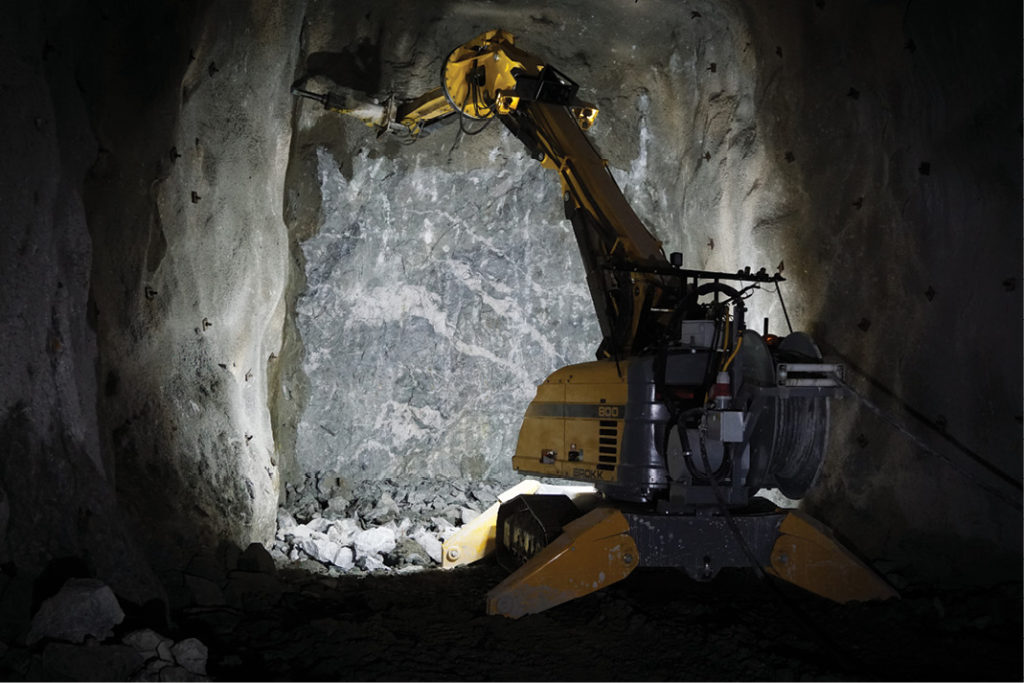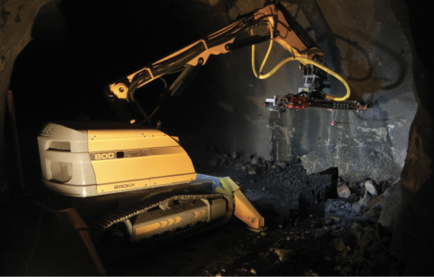Efficient shaft revitalization with remote controlled demolition equipment

The benefits of robotic equipment have long been understood in mining applications. However, common mining robots tend to be cumbersome and highly specialized — a great tool for drilling in large, open areas, but not much else. Looking to apply mechanized solutions to ultra-deep, narrow-vein applications, some operations are employing a different kind of robot. Compact, highly versatile remote-controlled demolition robots are uniquely suited for the demanding conditions deep underground. These compact machines offer exceptional power-to-weight ratios — on par with classic excavators three times their size — while an advanced three-part arm provides unrivaled range of motion for drilling, scaling, breaking, and bolting in any direction.
But there is a lot more these flexible, hard-hitting machines can offer modern mining operations. In addition to ultra-deep applications, the power and versatility of remote-controlled demolition machines make them an ideal solution for support tasks, such as shaft revitalization and maintenance. Miners are finding employing a demolition robot not only speeds up progress in these situations, but it also increases safety by taking on much of the physical work while keeping employees out of harm’s way.
Revitalization versatility
Mining techniques have changed over the years, and tonne per man has decreased steadily since the 1960s. For many operations, returning to old shafts with more modern equipment can supplement production. However, getting these shafts in shape to meet modern safety regulations can be a difficult process requiring substantial work. Most are littered with rubble, collapsed supports, and downed utilities, making the process of opening them up slow and dangerous.
In these types of situations, the versatility of remote-controlled demolition machines can minimize equipment and personnel requirements for highly efficient renovations. Armed with a suite of attachments, a demolition robot can perform almost any required task.

A breaker, for example, is used for scaling during initial refurbishment work, and a grapple is used to handle rubble and refuse to clear the bottom as well as assist in installing utilities. To dismantle old supports, steel or timber, a saw/grapple combination can be used. This reduces handling and cutting the steel to premium scrap lengths while working off a Galloway.
Primary and secondary blasting and rock bolting can all be managed with the drill attachments. Miners can then switch to a beam handler for erecting support ribs and installing wire mesh. These dexterous attachments can also be used for setting up new services such as rails, pipes, or cables. Finally, shotcrete attachments are also available.
More efficient maintenance
These attachments also make it easier for mines to maximize productivity for shaft and tunnel maintenance tasks. Replacing large crews with a small team and a demolition robot can result in a significantly more efficient process.
One operation was able to eliminate all manual labor in a shotcrete removal application and advance their maintenance schedule by months. They positioned the demolition robot on a platform that rotated around the core of a shaft boring machine. After the shotcrete was removed, they used the robot to pin and bolt new screening.
In addition to making shaft maintenance easier, demolition robots are increasing safety and efficiency for widening operations. They can be underhung from a Galloway stage, hammer, drill and blast, drill and split, and replace old clam buckets for mucking out.
The future of mining
With extensive equipment and attachment options available from innovative manufacturers, there is an opportunity to use demolition robots in just about every high-risk, heavy-labour shaft maintenance situation. The possibilities are only limited by the imagination.
Raymond Ippersiel is a training and application specialist for Brokk Inc. He has 10 years with the company and specializes in robotic demolition applications for the tunneling, process, and demolition industries. He has actively worked in all these industries as a machine operator since 1979.
Comments